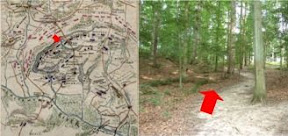 |
| From Gaines Mill |
Robert E. Lee assumed command of Johnston’s Army of Virginia in the confusion following Johnston’s wounding in the fighting at Seven Pines. Within days, Lee’s re-christened Army of Northern Virginia delivered a series of sledgehammer assaults against the right wing of McLellan’s Army of the Potomac. General Fitz John Porter commanded this wing of McLellan's army. He posted his troops in a strong position behind Boatswain’s Swamp along the northern bank of the Chickahominy River in the area of Gaines Mill. The battle of Gaines Mill in June 1862 was the second largest engagement, in terms of losses, fought between the armies of the Union and Confederacy up to that time.
When I last visited the Gaines Mill battlefield, the park unit consisted of a small plot of ground in the area of the Watt house, near the center of the Union position where Hood’s Texans broke through after a long day of fruitless assaults all along the line. Today, the battlefield is much larger, and includes a walking trail along the wooded ravine formed by Boatswain’s Swamp that offers views of the ridge defended by Porter’s Fifth Corp of the Army of the Potomac.
The steepness of the ridgeline above Boatswain’s Swamp allowed supporting lines of Federal soldiers to fire over the heads of their first line. Lee’s assault troops struggled from the outset, traversing thickly wooded slopes on both sides of a swampy morass running along the bottom of the ravine. Their formations broken by terrain and a withering fire, most of these assaults broke against the formidable Union position. Near the area where Hood’s Texans finally broke the Federal line, a draw descends to the bottom of the ravine, a ready avenue of attack offering a relatively sheltered approach.
As the trail winds its way southward along the ravine, it emerges near the Union left, where the final tragic scene of the battle of Gaines Mill played out. Here the 6th Pennsylvania Cavalry (Rush’s Lancers) formed for a last ditch charge to stall the Confederate advance. Their charge failed with predictable results and in the end, this only added to the confusion in the wake of Hood’s breakthrough.
My most recent visit to Gaines Mill offers a poignant lesson on battlefield preservation. True, the park service has preserved and interpreted much more of the site than when I last visited many years ago. But a fence stands at the bend in the trail where visitors view the area of the 6th Pennsylvania’s charge and a final desperate stand by Federal batteries overwhelmed in the chaos of defeat. These areas of the battlefield remain in private hands. I hope one day to return and find the trail extended to these areas of the battlefield. To that end, I am proud to be a member of the Civil War Preservation Trust. To find out more about CWPT and their efforts to preserve Civil War sites across the country, visit their web site at .


2 comments:
We came across your nlog in research for a 7th grade paper. Can you tell us some interesting personal facts or send us some links about the Civil War?
Sarinah,
I started my blog this Summer to share my battlefield experiences with those who cannot visit these historic sites as often as I do. I visit Gettysburg and Antietam regularly and usually spend at least one weekend every year touring battlefields in Virginia or Tennessee.
My parents introduced me to the Civil War at an early age. I ready "The Killer Angels" when I was 11 years old. Then I got hold of a copy of Stackpole's "They Met at Gettysburg," and I was hooked. It still recommend the Stackpole book to young readers or to anyone with a general interest in the battle of Gettysburg.
There are a number of excellent web sites and blogs for Civil War enthusiasts. The National Park Service maintains sites for all major battlefield parks, and these are a great start if you are considering a visit. Just go to http://www.nps.gov and search on the name of a battle to find the associated park sites. Civil War Interactive (http://www.civilwarinteractive.com) provides daily news, blog reviews, articles and more - it is a great place to start.
You may want to check out my favorite travel sites as well. Civil War Album (http://www.civilwaralbum.com) contains pictures of battlefields from across the country and includes a number of virtual tours. Civil War Traveler (http://www.civilwartraveler.com) includes information on Civil War Trails sites as well as podcast tours of a growing number of battlefield sites.
Check out the listing of my favorite blogs for great information on Civil War books and other matters.
I hope you enjoy researching the Civil War, and that you find some of the sites I have suggested to be of interest.
Steve
Civil War Battles and Battlefields
Post a Comment